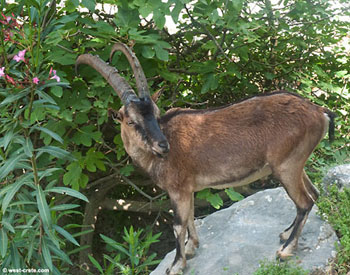Crete, the largest of the Greek islands, is renowned for its stunning landscapes, rich history, and vibrant culture. However, one of its most remarkable features is its diverse and unique flora and fauna. The island’s varied geography, from rugged mountains and deep gorges to lush valleys and pristine coastlines, creates a range of habitats that support a wide array of plant and animal life. For nature lovers, Crete is truly a paradise waiting to be explored.
1. Flora of Crete
Crete’s flora is one of the most diverse in Europe, with over 1,700 plant species, 10% of which are endemic to the island. This rich botanical diversity is a result of the island’s varied climate and terrain.
Wildflowers and Herbs: In spring, Crete’s countryside bursts into a riot of colors with wildflowers blooming everywhere. Anemones, irises, and orchids are particularly abundant. The island is also famous for its aromatic herbs such as thyme, oregano, sage, and rosemary, which not only add flavor to the local cuisine but also thrive in the wild, scenting the air with their fragrant oils.
Olive Trees: The olive tree is perhaps the most iconic plant in Crete, with some trees estimated to be over 2,000 years old. Olive groves are a common sight, and the island’s olive oil is renowned for its quality and flavor.
Rare Plants: Among the rarest plants is the Cretan tulip (Tulipa cretica), which blooms in the rocky terrains and meadows. Another notable species is the Cretan dittany (Origanum dictamnus), a rare herb known for its medicinal properties and endemic to the island’s mountainous regions.
Forests: The mountainous regions of Crete are home to extensive forests of cypress, pine, and oak. The island’s only native palm tree, the Cretan date palm (Phoenix theophrasti), can be found in the famous Vai Palm Forest in eastern Crete, one of the largest natural palm forests in Europe.
2. Fauna of Crete
Crete’s fauna is equally impressive, with a mix of species that reflect the island’s unique position at the crossroads of Europe, Asia, and Africa.
Birds: The island is a birdwatcher’s haven, with over 400 species of birds recorded. Crete lies on a major migratory route, making it an important stopover for many bird species. Raptors such as the griffon vulture, Bonelli’s eagle, and the golden eagle can often be seen soaring above the mountainous regions. Coastal areas and wetlands attract a variety of waterfowl, including flamingos and herons.
Mammals: While Crete has fewer mammals compared to the mainland, it does have some unique species. The most notable is the Cretan wild goat, or kri-kri, which resides in the rugged gorges and mountains. Other mammals include the Cretan shrew and the Cretan spiny mouse, both endemic to the island.
Reptiles and Amphibians: Crete is home to several species of reptiles and amphibians. The Cretan wall lizard is a common sight, and the island’s freshwater habitats support species like the Cretan frog. Snakes such as the leopard snake and the cat snake are also found on the island, though they are generally harmless to humans.
Marine Life: The waters surrounding Crete are teeming with marine life. Divers and snorkelers can encounter a variety of fish, sea turtles, and even monk seals. The island’s coastal waters are part of the Mediterranean monk seal’s habitat, one of the most endangered marine mammals in the world.
3. Conservation Efforts
Recognizing the importance of its natural heritage, Crete has established several protected areas and national parks to conserve its unique flora and fauna. Samaria Gorge, part of the White Mountains National Park, is one such area, known for its biodiversity and endemic species. Conservation efforts also focus on protecting the habitats of endangered species like the griffon vulture and the Mediterranean monk seal.
4. Nature Trails and Ecotourism
For nature enthusiasts, Crete offers numerous trails and opportunities for ecotourism. The E4 European long-distance path runs across the island, providing hikers with access to some of the most breathtaking landscapes and diverse ecosystems. Guided nature tours, bird-watching excursions, and botanical walks are also available, allowing visitors to learn about the island’s natural history and conservation efforts.
5. Seasonal Highlights
Different seasons bring different natural spectacles to Crete. Spring is the best time to see wildflowers in bloom, while autumn is ideal for birdwatching as many species migrate through the island. Summer and early autumn are great for exploring the marine life along the coast.
Conclusion
Crete’s extraordinary biodiversity makes it a paradise for nature lovers. Whether you are interested in hiking through ancient forests, bird-watching in serene wetlands, or diving in crystal-clear waters, Crete offers an unparalleled opportunity to connect with nature. By exploring and appreciating this unique island, you contribute to the conservation of its natural treasures, ensuring that future generations can enjoy Crete’s flora and fauna just as much as you do.


